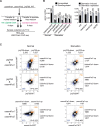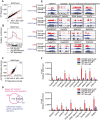SnRK1 stimulates the histone H3K27me3 demethylase JMJ705 to regulate a transcriptional switch to control energy homeostasis
- PMID: 34498077
- PMCID: PMC8643663
- DOI: 10.1093/plcell/koab224
SnRK1 stimulates the histone H3K27me3 demethylase JMJ705 to regulate a transcriptional switch to control energy homeostasis
Abstract
Plant SNF1-Related Kinase1 (SnRK1) is an evolutionarily conserved energy-sensing protein kinase that orchestrates transcriptional networks to maintain cellular energy homeostasis when energy supplies become limited. However, the mechanism by which SnRK1 regulates this gene expression switch to gauge cellular energy status remains largely unclear. In this work, we show that the rice histone H3K27me3 demethylase JMJ705 is required for low energy stress tolerance in rice plants. The genetic inactivation of JMJ705 resulted in similar effects as those of the rice snrk1 mutant on the transcriptome, which impairs not only the promotion of the low energy stress-triggered transcriptional program but also the repression of the program under an energy-sufficient state. We show that the α-subunit of OsSnRK1 interacts with and phosphorylates JMJ705 to stimulate its H3K27me3 demethylase activity. Further analysis revealed that JMJ705 directly targets a set of low energy stress-responsive transcription factor genes. These results uncover the chromatin mechanism of SnRK1-regulated gene expression in both energy-sufficient and -limited states in plants and suggest that JMJ705 functions as an upstream regulator of the SnRK1α-controlled transcriptional network.
© American Society of Plant Biologists 2021. All rights reserved. For permissions, please email: journals.permissions@oup.com.
Figures











Similar articles
-
WOX11 recruits a histone H3K27me3 demethylase to promote gene expression during shoot development in rice.Nucleic Acids Res. 2018 Mar 16;46(5):2356-2369. doi: 10.1093/nar/gky017. Nucleic Acids Res. 2018. PMID: 29361035 Free PMC article.
-
Jumonji C domain protein JMJ705-mediated removal of histone H3 lysine 27 trimethylation is involved in defense-related gene activation in rice.Plant Cell. 2013 Nov;25(11):4725-36. doi: 10.1105/tpc.113.118802. Epub 2013 Nov 26. Plant Cell. 2013. PMID: 24280387 Free PMC article.
-
The AMPK/SNF1/SnRK1 fuel gauge and energy regulator: structure, function and regulation.FEBS J. 2011 Nov;278(21):3978-90. doi: 10.1111/j.1742-4658.2011.08315.x. Epub 2011 Sep 26. FEBS J. 2011. PMID: 21883929 Review.
-
The C/S1 bZIP Network: A Regulatory Hub Orchestrating Plant Energy Homeostasis.Trends Plant Sci. 2018 May;23(5):422-433. doi: 10.1016/j.tplants.2018.02.003. Epub 2018 Mar 7. Trends Plant Sci. 2018. PMID: 29525129 Review.
-
Default Activation and Nuclear Translocation of the Plant Cellular Energy Sensor SnRK1 Regulate Metabolic Stress Responses and Development.Plant Cell. 2019 Jul;31(7):1614-1632. doi: 10.1105/tpc.18.00500. Epub 2019 May 13. Plant Cell. 2019. PMID: 31123051 Free PMC article.
Cited by
-
Phosphoribosyltransferases and Their Roles in Plant Development and Abiotic Stress Response.Int J Mol Sci. 2023 Jul 23;24(14):11828. doi: 10.3390/ijms241411828. Int J Mol Sci. 2023. PMID: 37511586 Free PMC article. Review.
-
A DNA adenine demethylase impairs PRC2-mediated repression of genes marked by a specific chromatin signature.Genome Biol. 2023 Aug 30;24(1):198. doi: 10.1186/s13059-023-03042-4. Genome Biol. 2023. PMID: 37649077 Free PMC article.
-
A natural variation in OsDSK2a modulates plant growth and salt tolerance through phosphorylation by SnRK1A in rice.Plant Biotechnol J. 2024 Jul;22(7):1881-1896. doi: 10.1111/pbi.14308. Epub 2024 Feb 12. Plant Biotechnol J. 2024. PMID: 38346083 Free PMC article.
-
Management of plant central metabolism by SnRK1 protein kinases.J Exp Bot. 2022 Nov 15;73(20):7068-7082. doi: 10.1093/jxb/erac261. J Exp Bot. 2022. PMID: 35708960 Free PMC article. Review.
-
Lysine acetylation of histone acetyltransferase adaptor protein ADA2 is a mechanism of metabolic control of chromatin modification in plants.Nat Plants. 2024 Mar;10(3):439-452. doi: 10.1038/s41477-024-01623-0. Epub 2024 Feb 7. Nat Plants. 2024. PMID: 38326652
References
-
- Baena-Gonzalez E, Hanson J (2017) Shaping plant development through the SnRK1-TOR metabolic regulators. Curr Opin Plant Biol 35: 152–157 - PubMed
-
- Baena-Gonzalez E, Rolland F, Thevelein JM, Sheen J (2007) A central integrator of transcription networks in plant stress and energy signalling. Nature 448: 938–942 - PubMed
-
- Broeckx T, Hulsmans S, Rolland F (2016) The plant energy sensor: evolutionary conservation and divergence of SnRK1 structure, regulation, and function. J Exp Bot 67: 6215–6252 - PubMed
Publication types
MeSH terms
Substances
LinkOut - more resources
Full Text Sources
Other Literature Sources

